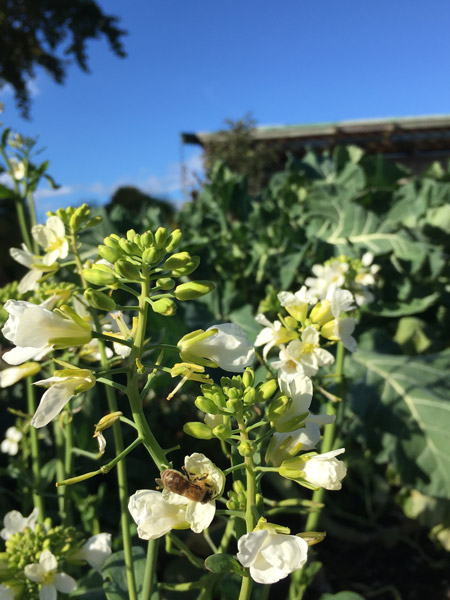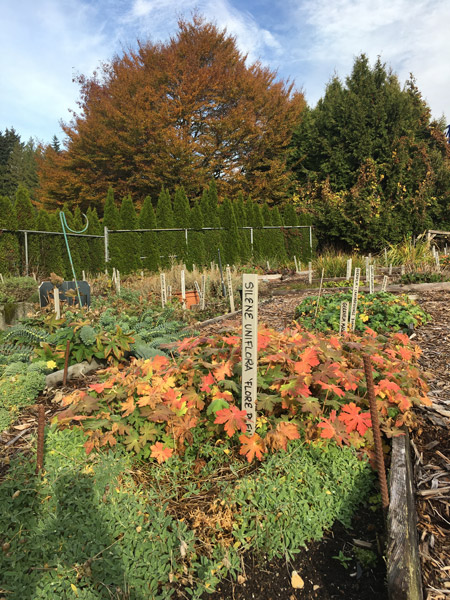 Submitted by: Erin Despard, Artist in Residence. Last fall, UBC Botancial Garden welcomed our new Artist in Residence, Dr. Erin Despard. Learn more about Erin’s residency.
Submitted by: Erin Despard, Artist in Residence. Last fall, UBC Botancial Garden welcomed our new Artist in Residence, Dr. Erin Despard. Learn more about Erin’s residency.
“An Education in Propagation” is an ongoing blog post series by Dr. Erin Despard, Artist in Residence at UBC Botanical Garden, exploring the fascinating relationships between people, plants and the methods and technologies used to grow them. Read the Part 2 and Part 3 of this blog post series.
Propagation is the practice of using plants to make more plants. There are two main ways to do it. The first—collecting and germinating seeds—depends on sexual processes of reproduction. The second, which encompasses a range of techniques—everything from root division to stem cuttings, grafting, and layering—depends on vegetative reproduction or cloning.
Some practices of propagation involve a relatively light touch—simply covering fallen seeds for example, or pulling bulblets or rhizome sections off a plant that is reproducing vegetatively on its own. Others require highly detailed knowledge of specific plants, specialized equipment and vigilant control of temperature and humidity. To me, they all have the potential to change your perspective in powerful ways. To make plants rather than buy them, can cause you to feel both radically self-sufficient and humbled by the fact that these processes are already going on without fanfare all around you.
In the first phase of my residency, I have been visiting the garden with staff and UBC Friends of the Garden (FOG) volunteers to learn about all the different ways that plants get made at the Garden. One of the reasons I am interested in propagation is that it is a good way to expand, not just your understanding of plants, but also your appreciation of the relationships in which they are embedded.
Perhaps the most important, most general relationship that underlies propagation, is similar to that which underlies the existence of the botanical garden in the first place. As Douglas Justice, the Associate Director of the Garden’s collections, reminded me on my first visit, the science of botany depends in some key ways on the practice of horticulture: without gardeners, there would be no collections of plants for researchers to study. Similarly, without all the human and non-human contributors (e.g. pollinators) to processes of propagation, there would be very few plants out of which to form collections.
In some areas of the Garden, the multispecies relationships enabling propagation are clearly on display. For example, in the Food Garden, horticulturist Linda Layne explained to me that she lets some plants go to seed so that visitors can see what they look like in the later stages of their lifecycles and observe the birds or insects that pollinate those plants and/or eat their seeds. She also allows beneficial weeds and wildflowers (such as borage and wild strawberry) to self-propagate in certain areas. These plants provide a “living mulch” that also helps to ensure forage for pollinators throughout the growing season.

A flowering Gai Lan plant (Brassica oleracea var. alboglabra), with pollinator, in the Food Garden.
In other areas, the relationships that enable propagation are more hidden. You may already know that some of the plants sold in The Shop in the Garden and at plant sales are propagated by FOG volunteers, but you may not be aware that, in some cases, there are multiple layers of personal history that have helped to bring them there. As Ronda Tuyp, founder of the FOG propagation committee explained to me, some plants are raised by current volunteers from seed or bare roots. Others, however, are propagated from cuttings of plants that were bred by FOG members devoted to a particular species (e.g., Pelargoniums), or from divisions of perennials that were donated many years ago by members who had cultivated them in their own gardens—sometimes over a whole lifetime of gardening. These plants come to the Garden as a product of the love and pleasure felt by those who first bred or cultivated them, and they arrive in the Shop (or at sales) as a product not just of hard work and horticultural expertise, but also cooperation, altruism and friendship among the volunteers who raised them. [Note: See an example of FOGs selling plants propagated from cuttings partway down this blog entry titled “FOGs get creative with pelargonium and sweet pea sales.”]

The Back Forty in autumn.
Meanwhile, in the greenhouse used by the Horticultural Training Program, it is the relationship between plants and their environments that is most clearly in evidence. There, I had a chance to experience for myself some of the learning that propagation enables. Under the guidance of Chief Instructor Egan Davis, I prepared the medium into which cuttings would be stuck, which taught me about how water interacts with different materials. Then, in the process of taking cuttings, I learned about the subtle ways in which a plant’s growth changes over the season, making it more or less conducive to successful propagation. Finally, I observed the interacting effects of heat and humidity on the soil, and the way differences in foliage make plants more or less susceptible to problems. According to Egan, this kind of general knowledge will get you a surprisingly long way—that is, if you are working with plants that are easy to propagate (e.g., evergreen, fast-growing and/or hardy species).

Cuttings in the process of rooting in the HTP greenhouse.
Of course, this is often not the case in a botanical garden, where the objective is to present a great variety of plants from all over the world – many of which hold significant conservation value. Much of the propagation that takes place at UBC Botanical Garden consequently requires a high degree of specialized expertise and technical coordination. My next blog post will describe what I learned when I visited the south campus greenhouses, where the garden’s hardworking propagator, Kevin Kubeck, grows the majority of plants that make up the garden’s collections.
It turns out that, even there, botanical knowledge and horticultural practice are intimately intertwined. Exploring how propagation practically works in this more specialized setting offers further perspective on the myriad of human and non-human relationships that sustain a botanical garden, but may otherwise be invisible or get taken for granted.
